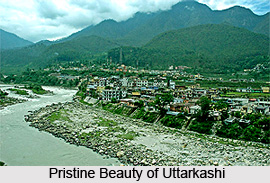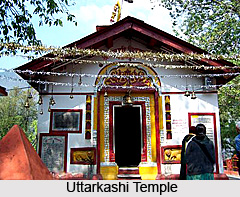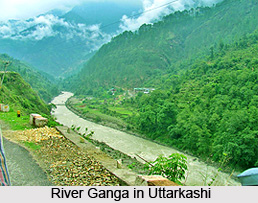 Uttarakashi is the place of ancient Hindu temples of great mythological importance. On the banks of the Bhagirathi, surrounded by the rivers Varuna and Assi, this sacred, fast developing town is the capital of the newly constituted westernmost district of Uttarakhand along the Indian border.
Uttarakashi is the place of ancient Hindu temples of great mythological importance. On the banks of the Bhagirathi, surrounded by the rivers Varuna and Assi, this sacred, fast developing town is the capital of the newly constituted westernmost district of Uttarakhand along the Indian border.
Uttarakashi is a town packed with temples, historical monuments, `ashrams` and `dharamsalas`. It is a Shiva town populated by over 12,000 people. Lord Shiva is the leading deity and is worshipped morning, noon and night in the ancient temple of Lord Vishwanath. The evening song evokes an atmosphere of beauty in religion as the music of singing bells blends with the chants of the pandits. Within the courtyard and directly opposite to the temple is the Shakti Temple dedicated to the Goddess of Energy, projecting a massive brass trident which, according to an inscription in Sanskrit fixed on it reveals that the temple of Vishwanath was built by king Ganeshwar, whose son, Guh a great warrior, had the trident forged. It is 8 metres high with a base measuring 2.74 metres and atop measuring almost a metre in circumference. Another inscription bearing trident, on a smaller scale, can be found in the Shiva Temple in the town of Gopeshwar, near Chamoli.
 Among the other temples in this many splendour town are the Parashuram, Kali and that of the Ekadash Rudra, built by the former maharaja of Jaipur and where, in the days of yore, two brave heroes, Kirat and Arjuna dwelled until death took Kirat. Above the town is the temple of Sri Chandreshwar, situated on Varunavat Parbat with commanding magnificence and dignity. Besides the Anglo-Sanskrit College, and the old seat of the Deputy Collector, there are the Kshettras of the Baba Kali Kamli Wala, the Maharaja of Jaipur and the Punjab Sind Kshettra.
Among the other temples in this many splendour town are the Parashuram, Kali and that of the Ekadash Rudra, built by the former maharaja of Jaipur and where, in the days of yore, two brave heroes, Kirat and Arjuna dwelled until death took Kirat. Above the town is the temple of Sri Chandreshwar, situated on Varunavat Parbat with commanding magnificence and dignity. Besides the Anglo-Sanskrit College, and the old seat of the Deputy Collector, there are the Kshettras of the Baba Kali Kamli Wala, the Maharaja of Jaipur and the Punjab Sind Kshettra.
On the day of Makar Sankranti, Uttarakashi in Uttarakhand is energetic and enthusiastic with the costumes of the people from the surrounding villages while the gods and goddesses are carried through the town, men, women and children throng the temples at the banks of the Ganga River. The colourfully dressed women bejeweled with chunky ornaments, worn on festive occasions, join the men in song and dance as music fills the air. The Ganga, worshipped as the `Mother` who gives life to the making the most fertile Gangetic plains, now she is providing energy with the construction of the series of hydroelectric projects in the hills. Here, in Uttarakashi is the Maneri-Bhali Project, on the left bank of the Bhagirathi generating 93 MW of power. The Peshwa ruler, Naina Saheb Dhundu, while in exile, built the inspection House in Uttarakashi in Uttarakhand.
 Kuteti Devi Temple, situated on Hari Parbat, on the banks of the Bhagirathi, Kuteti Devi is the main deity of Kot Gram Khai in Uttarakashi , Uttarakhand. Legend says that Kuteti Devi is a form of Durga. The daughter of the Maharaja of Kota and her husband, exactly on the spot where they had discovered three stones with a heavenly aroma, as guided by the Devi in their dreams, built this temple. A kilometer from Uttarakashi , live some of the over 500 `sadhus` and `sanyasis` in a colony termed Ujali. Some are scholars of reputation. Thousands of pilgrims passing through on their way to the Yatra add to the wealth of the town and maintains the economy of the district, where hills are deeply forested, and the terraces are fully cultivated.
Kuteti Devi Temple, situated on Hari Parbat, on the banks of the Bhagirathi, Kuteti Devi is the main deity of Kot Gram Khai in Uttarakashi , Uttarakhand. Legend says that Kuteti Devi is a form of Durga. The daughter of the Maharaja of Kota and her husband, exactly on the spot where they had discovered three stones with a heavenly aroma, as guided by the Devi in their dreams, built this temple. A kilometer from Uttarakashi , live some of the over 500 `sadhus` and `sanyasis` in a colony termed Ujali. Some are scholars of reputation. Thousands of pilgrims passing through on their way to the Yatra add to the wealth of the town and maintains the economy of the district, where hills are deeply forested, and the terraces are fully cultivated.



















